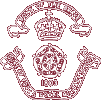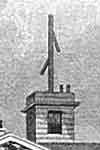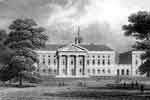


 |
 |
|
 |
||
| Navigation links at the bottom of this page | |||||||
Newspaper reports of the RMA |
|||||||
Editorial note: News of work, official visits and items of local interest were from time to time considered of sufficient interest to be published in the London newspapers, but particularly in The Times. Some reports are longer than others. In other instances, the newspaper entry is irritatingly brief. When additional information (obtained from other sources of research) is known, newspaper reports are, when clarification is deemed useful, supplemented with editorial text in italics. For example: A brief report appeared in The Times for 20 June 1801 as follows: |
|||||||
| Foundation stone laid by the Duke of York | |||||||
| Construction of the Asylum on land leased from Lord Cadogan and other property owners was begun in 1801 and the foundation stone laid the Duke of York. In addition to the board of governors, those persons present of note were Sir Brook Watson (1735-1807), who was Commissary-General in Canada 1782-3. He had been with York in Flanders and, in 1801, was a director of the Bank of England. Lord Pelham (1756-1826) was the Home Secretary under Addington in 1801 and had been Secretary of Ireland (referred to as the Irish Secretary) from 1795 to 1798. |
|||||||
18 June 1803 (Report in The Times) On Thursday next, his Majesty will inspect the Royal Military Asylum, at Chelsea which contains 1000 children, the orphans of soldiers of the regular army, and also Chelsea College where his Majesty will breakfast with the governor Sir Davis DUNDAS. The Queen's Volunteers will be on duty at the Asylum and College, and the veterans will fire 3 grand volleys on the occasion at 1 o'clock in the principal court. The band belonging to the Queen's Volunteers and Scots Greys will attend and play during breakfast. |
|||||||
This report of a visit by King George III to inspect the Asylum was not accurate because there were not children on the premises in June 1803. The first orphans arrived on Tuesday, 30 August 1803 from General George Hewett's farm orphanage on the Isle of Wight. His Majesty might well had breakfasted with Sir David Dundas at the Chelsea College as reported. Chelsea College was the Royal Chelsea Hospital (Chelsea Pensioners) of which Dundas was then governor of the hospital. |
|||||||
18 June 1805 (Report in The Times) ROYAL VISIT TO CHELSEA HOSPITAL About ten o'clock on Thursday morning, their Majesties left the Queen's House, in a carriage and four, and were followed by the princesses, the Duke and Duchess of York, the Dukes of Cumberland, Cambridge and Kent, and several of the Royal Attendants. On the arrival of their Majesties, &c. at Chelsea Hospital, General Sir David DUNDAS, KB the governor of the hospital, and General DALRYMPLE, the Lieutenant Governor of the Hospital, were in readiness to receive the Royal Party at the gate, and conducted them to the inner square, when the veterans were drawn up, and as many of them as could bear arms, saluted the Royal visitors. The Royal guests were conducted by the governor and other officers, to the different wards of the Hospital, to the Chapel, &c. His Majesty himself even requested to see the kitchens, which he did, and on the whole was fully satisfied that every care was taken to make the soldiers, who had bled in their country's cause, comfortable and happy. Their Majesties and the party next visited the Royal Military Asylum, where they partook of a cold collation. The boys and girls were drawn up in their dinner rooms, and on the entrance of the Royal visitors, they sang the first verse of "God save the King." Grace was then said, and the children sat down to dinner, which was provided for the occasion of beef and plum pudding, which they ate in the presence of the King, Queen, Princesses, &c. The Royal family then visited the other parts of the Asylum, and expressed great satisfaction at the manner at which it was conducted, and particularly observed the healthy appearance of the children. They were attended on this last visit by the Barrack-Master General, the Adjutant-General, Sir Sidney SMITH, and about fifty other persons. |
|||||||
| Note that girls were still being admitted to the institution at this time. They were not excluded until 1847 when the last girl left. |
|||||||
26 Feb 1825 (Report in The Times) The first division of the boys from the Royal Military Asylum at Chelsea, marched in procession from thence to Spring Gardens last Thursday to view, by invitation, the new Peristrephic Panorama. The regular and healthy appearance of this mionic squadron, with their full military band and Corps of Drums and Fife, is a pleasing sight, the boys were delighted with the Panorama and the crowd there was immense. |
|||||||
| By 1825, the girls of the RMA had been moved to the Southampton Branch. The Southampton Cavalry Barracks were converted and renovated to accommodate both girls and infants from the Isle of Wight. |
|||||||
12 August 1837 (Report in The Times) The Queen, it is said, has signified her intentions of visiting the institution, and of inspecting the establishment. Her Majesty accompanied by her suite of Staff Field Officers, will review the youthful inmates in the Park attached to the Asylum. Great preparations are being made by all the officers connected with the department, to receive her Majesty with all due honour, and to celebrate the event, a new anthem, composed expressly for the occasion, will be played by the full band of the school. The composition is a most splendid one, and has lately been rehearsed frequently by the young musicians, who, doubtless will use their best efforts to give the piece all due effect. The day has not yet been fixed. |
|||||||
| The musical composition identified as 'a new anthem' is not recognized. |
|||||||
20 December 1840 (Report in The Times) THE ROYAL MILITARY ASYLUM CHELSEA It was arranged some time since that the telegraph on the roof of the Royal Military Asylum, in connection with that at the Admiralty, and continuing over Wanstead Heath in a direct line to Portsmouth, should be taken down and removed with the whole of the machinery necessary for working it, to the Royal Hospital, in consequence of it being found that the steeple of the handsome new church now in course of erection on the Marquis of Westminster's estate in Pimlico, at the west end of Chester Square, would be greatly in the line of view, and would effectually prevent it being worked for the important purpose for which it was erected; The Lords Commissioners of the Admiralty sanctioning the removal on the condition that the noble Marquis should be at the sole expense of the removal, and of refitting the same in its new position. We understand that it has since been determined not to erect the telegraph on the roof of the hospital some fresh difficulty has presented itself, but to remove the whole apparatus to the southern end of the original building, from which spot it can be worked without any interruption, the change causing but very trifling inconvenience to the establishment, and the new position answering the purpose especially well. |
|||||||
 |
|||||||
 |
|||||||
| Semaphore signalling unit mounted on the RMA building for use by the Admiralty for communicating with Plymouth. | Enlarged view of the signalling semaphor on the roof. | ||||||
| Thanks to Peter Goble, the church to which reference is made in this article – stated to be under construction on the Marguis of Westminister's estate – has been identified as St Michael's, Pimlico. | |||||||
 |
|||||||
| A recent view of St. Michael's Church, Chester Square as seen by artist Don Grant; printed by Just Post Cards@London | |||||||
19 August 1847 (Report in The Times) Royal Surrey Zoological Gardens On Tuesday last, the boys of the Royal Military Asylum, Chelsea, accompanied by their juvenile band, visited these gardens by the kind permission of the proprietors. This institution, better known by the name of the Duke of York's School, was founded by the late Duke of York, who was indeed most truly '"The soldiers friend". The little fellows comprising the band played many pieces in a very spirited manner, and all departed highly delighted with their day's entertainment. |
|||||||
| 1847 was the year in which the last girl admitted to the Asylum took her departure. The subject of female students in the early institution is dealt with more fully in 'The Charity of Mars' (Black Cat Press, 2003). |
|||||||
15 July c. 1848 (Report in The Times) Royal Military Asylum Bill A Bill just brought in by the Government reciting that there is a sum of £67,894 in the 3 per cents,* arising from forfeited and unclaimed prize money, authorizes the appropriation of £7000 from this fund to the enlargement of the Royal Military Asylum at Chelsea, for the reception of the children of soldiers. |
|||||||
| * The reference here is, presumably, to British Consul stock, which the governors favoured for the investment of funds managed on behalf of children who inherited money from a parent or parents. | |||||||
| ||||||||||
|
© A. W. Cockerill 2011 Site Map Contact me | ||||||||||